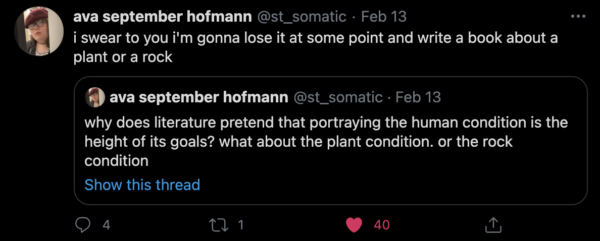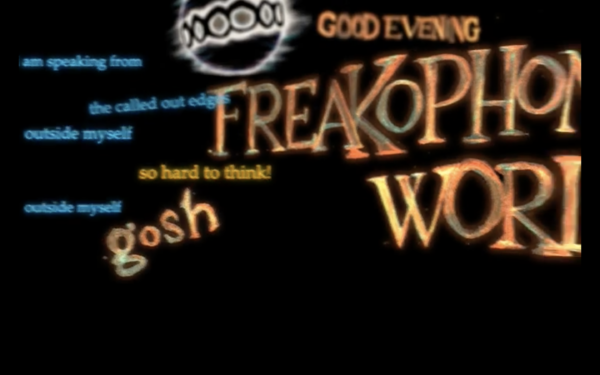I’m very excited to have contributed the “American Poetry” manifesto to the all-new anthology Neo-Decadence: 12 Manifestos (Snuggly Books, 2021)—edited by Justin Isis. You can read excerpts from all 12 manifestos in a recent post at Dennis Cooper’s blog.
Today, I’d like to focus on Jeremy Reed‘s manifesto: “English Poetry: Neo-Decadence is the New Real.” In his manifesto, Reed claims Neo-Decadent fiction is about integrating “practices of synthetic biology into their subjects’ psychological and physical makeup” and he focuses on the excessive, poetic prose of SF authors like J.G. Ballard, William Gibson, and William Burroughs:
What Neo-Decadence provides, or should do, is the narrowing of the bandwidth between fiction and poetry, in what I’ve described the likes of Ballard, Burroughs and Gibson as arguably writing poetry in the more expansive space provided by prose, in a form I call meta-poetry, which reduces most other contemporary poetry to the status of employing a bleached language devoid of high-tech or the experimental unpacking of bizarre phenomenology. British poetry, unlike American, is irrevocably sucked backwards into maintaining an increasingly tired language that excludes in most cases our dizzying acceleration into techno-apocalyptic realities.
While I am tempted to add James Tiptree Jr. to the list (i.e. The Girl Who Was Plugged In), I support Reed’s move to link the cyberpunk genre with Neo-Decadence, but I hesitate to embrace the connection to futurity. As something “always ahead.” I don’t quite understand how social degeneration could be something a Neo-Decadence lacks. Maybe this is something that separates Decadence from Neo-Decadence? I’ve been thinking a lot about this. Reed argues the key difference is “intensified visual imagery.” I don’t necessarily disagree, but I’m also realizing I might not be a Neo-Decadent. I might just be a Decadent…
Reed also feels British poetry “excludes” a language of “techno-apocalyptic realities” and he might be right.
To me, Decadence represents the future and the new real, rather than the historic module of an objectively observable social degeneration in which the arts are implicated by the etiolation of a corrupt aesthetic.
I don’t understand how Decadence can represent the future since its very name implies a social decline.
I reminded Action Blog readers of such a decline in a past post called “We are Decadent Again“:
Now, in quarantine, our only future is the present. “Decadence” – decay – decline – a declyining – cadēre – a fall.
In other words, a non-future. In the realm of Decadence—or Neo-Decadence—one can, of course, speculate and write intoxicating techno-apocalyptic languages inspired by, say…a future junked Tesla, for instance!
At times, I believe Reed wants precisely what it sometimes feels like he’s arguing against. The “etiolation of a corrupt aesthetic.” He even cites the cut-up method as Neo-Decadent because it is “disruptive.” (I agree!) It causes a disturbance. As far as American poetry goes, it disturbs the award-winning humanist poetry that never dares disturb.
When I think of disturbance, I think of the Decadence of the Anthropocene. I think of this passage from Anna Lowenhaupt Tsing’s The Mushroom at the End of the World:
Disturbance opens the terrain for transformative encounters, making new landscape assemblages possible.
Humanists, not used to thinking with disturbance, connect the term with damage. But disturbance, as used by ecologists, is not always bad—and not always human […] Whether a disturbance is bearable or unbearable is a question worked out through what follows it: the formation of assemblages
Too much humanism is a dangerous thing. Admittedly, I was quite heartened to see this recent tweet from Action Blog contributor Ava Hofmann:

I think Neo-Decadence can be something “new” without investing too much in futurity. In the present, while considering objected-oriented ontology, Neo-Decadence can be about erecting new landscape assemblages as we walk among the ruins of society. The narrative doesn’t necessarily have to be human-centered. Your next book can be about re-formation. Re-territorialization. Like Wilde’s green carnations, it can be about a celebration of the synthetic. If this Neo-Decadent moment at present is, in fact, the “New Real,” I wonder if it’s an antimimetic Real? If we are progressing towards the virtual, what utility does words like “Real” and “Realism” have when it comes to aesthetics?
One thing Reed and I definitely agree on is the Neo-Decadent need for transgression. A burning, frenetic “gem-like” transgression. These passages from Will Alexander’s “Transgression of Genre as Vitality” come to mind:
Transgression as fire, as magic generating agent, which eats at the axial monolith of genre with fumes from an encroaching lava. A feral lava of transmuted sting rays, of philosophical assault tribes, becomes a hurricane of verbal androgyny […] The amperage of mixture, of surreptitious masquerade, wandering like a skittish horse across moats of sparkling iridium, leading to a hall where a greenish turpentine angel is addressing in occulted Farsi an antimimetic gallery of skulls.
Finally, here’s some excerpts from just a few of the poets I mention in my “American Poetry” manifesto—poets who seem to be working within the same Neo-Decadent bandwidth that Reed describes in his manifesto:
Will Alexander
my body being of dark electrical thorns
like a watery desert of deserted veins
fishing for serpents
embroiled by Gamma Cygni
a “White supergiant 800 light years away”it enhances grace
it spins the body in physical movement
like a stunning kind of pictograph
above my “intrapsychic conflict”
I am never within the structure of jealousy or depression
electrically hidden in massless ice sheets
more
like an evasive expansivity
unblemished by extrinsic numeration held by the cube or the volumeit is above galactic latitude
like a lepton fountain
dispersed by geocentric parallax
by a simple dwarfing containmentperhaps I am more condoned
by the “Hirayama” family of asteroids
that I have broken with human motion
in that the cells
are collected & dispersedcollected on the level of the prone & visible body
then dispersed on a plane much higher than neutrinos-from The Sri Lankan Loxodrome (New Directions, 2009)
Aase Berg
The lipstick
and my body parts
scattered in the relief of
Incredible DeniabilityYou have no idea
what beautiful breasts I have
What pale hands
slink sensually through netsThe free net and the dark one
eternally lonely
in my algorithmic sequence
a misconfigured
open proxy serverwhen the black box
sinks softly
down to the ocean floor
outside of China
-from Hackers (Black Ocean, 2017) | Translated by Johannes Göransson
Johannes Göransson
The mis-en-scene is themed by fantasies from the 1950s about your mother and decay. The eel seems to be alive at Starr’s feet, the roses are made of x-rays. Scattered decay products look limber, soft. The light is light blue, the lame crinkles when Starr moves. The angiosperms seem to be in the hundreds at her feet. The metallic ornaments seem to come from Triassic Period, the extinction features is what they are called. Is what your mother calls them when you dream about home. You can think of this stage as a mother seen through the eye of a hypodermic needle. You can think of the stage as a threat. It’s a threat against me: If we must destroy, lets destroy ourselves.
Madison McCartha

[Click] to view the poem
Joyelle McSweeney
Flet is flying on the Great Deciduous Plateau. Few trees are left here, but the earth itself is somewhat deciduous, rising and falling away to an angular rhythm. Here and there, run-off carves odd, soapy-looking characters in the dirt. Florid survivor-flowers that thrive in the exhaust-blanket wave with lobotomized cheer from the median strip. They look like poppies, probably modified. The guardrails run on like faded ribbon.
The guardrails run on like a faded ribbon, like an unbroken thought, a single slate-grey condition. Last year eighty percent of the Nation’s guardrails were fitted with intelligent strips that could register whose hands had touched them, whose breath had elapsed near them, or so the Administration had announced. Looking out at this gently warped and dusty-looking material running on for miles, Flet wonders for the first time if it’s true. If anything is true. If everything is true. Could the sensors hold up under all this heat? Isn’t this the same unadulterated, saggy-looking material that has always run in her periphery, from her earliest, unplaceable memory of riding, her cheek against the pedestal lock, her fat legs burning on the dark blue vinyl seats?
On the other side of the highway, citizens speed along behind shields of solid light.
-from Flet (Fence Books, 2007)
Ed Steck
A strawberry is a very soft thing, always imaginable, as if a sensory notation forms its own intelligible integration before a particular categorization is perceived. A taste forms in a lulled subject, sprawled on a blanket — a working leg bent in at the knee under an unresponsive supporting leg lacking muscle — behind a body no longer recognizable as a body.
Skin is skin flowering scorched transitions of natural matter into atmospheric policed mass-surveillance pseudo-states. Two insurgents following changes of charged material signal intelligence monitored by inclined systems. Cyclical sources loop system components on a remote database: screenshot distance peaks remote monitor flattened panoramic interest.
-from The Garden: Synthetic Environment for Analysis and Simulation (Ugly Duckling Presse, 2013)
Paul Cunningham is the author of the The House of the Tree of Sores (Schism2 Press, 2020) and his latest chapbook is The Inmost (Carrion Bloom Books, 2020). He is the translator of Helena Österlund’s Words (OOMPH! Press, 2019) and two chapbooks by Sara Tuss Efrik: Automanias Selected Poems (Goodmorning Menagerie, 2016) and The Night’s Belly (Toad Press, 2016). He is a managing editor of Action Books, co-editor of Radioactive Cloud, and co-curator of the Yumfactory Reading Series. He is a PhD candidate at the University of Georgia. @p_cunning
